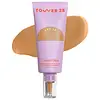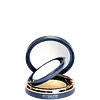Tower 28 Beauty SunnyDays Tinted SPF 30 Versus SkinBetter Science Sunbetter Tone Smart SPF 68 Sunscreen Compact
What's inside
What's inside
 Key Ingredients
Key Ingredients

 Benefits
Benefits

 Concerns
Concerns

 Ingredients Side-by-side
Ingredients Side-by-side

Zinc Oxide 12.6%
Cosmetic ColorantWater
Skin ConditioningIsononyl Isononanoate
EmollientC9-12 Alkane
SolventButyloctyl Salicylate
Skin ConditioningPolyglyceryl-6 Polyricinoleate
EmulsifyingCaprylic/Capric Triglyceride
MaskingGlycerin
HumectantEthylhexyl Methoxycrylene
Skin ConditioningTrimethylsiloxysilicate
EmollientMica
Cosmetic ColorantPolyglyceryl-2 Isostearate
EmulsifyingSodium Chloride
MaskingPhenoxyethanol
PreservativeDisteardimonium Hectorite
StabilisingPolyglyceryl-3 Polyricinoleate
EmulsifyingPolyhydroxystearic Acid
EmulsifyingCoco-Caprylate/Caprate
EmollientIsostearic Acid
CleansingLecithin
EmollientPolyglyceryl-6 Polyhydroxystearate
EmulsifyingJojoba Esters
EmollientEthylhexylglycerin
Skin ConditioningSodium Phytate
Aloe Barbadensis Leaf Water
MaskingCentella Asiatica Extract
CleansingOpuntia Tuna Fruit
Skin ConditioningSalvia Officinalis Extract
AntimicrobialIron Oxides
CI 77891
Cosmetic ColorantZinc Oxide 12.6%, Water, Isononyl Isononanoate, C9-12 Alkane, Butyloctyl Salicylate, Polyglyceryl-6 Polyricinoleate, Caprylic/Capric Triglyceride, Glycerin, Ethylhexyl Methoxycrylene, Trimethylsiloxysilicate, Mica, Polyglyceryl-2 Isostearate, Sodium Chloride, Phenoxyethanol, Disteardimonium Hectorite, Polyglyceryl-3 Polyricinoleate, Polyhydroxystearic Acid, Coco-Caprylate/Caprate, Isostearic Acid, Lecithin, Polyglyceryl-6 Polyhydroxystearate, Jojoba Esters, Ethylhexylglycerin, Sodium Phytate, Aloe Barbadensis Leaf Water, Centella Asiatica Extract, Opuntia Tuna Fruit, Salvia Officinalis Extract, Iron Oxides, CI 77891
1,2-Hexanediol
Skin ConditioningAcrylates/Dimethicone Copolymer
Skin ConditioningAlumina
AbrasiveBis-Vinyl Dimethicone/Dimethicone Copolymer
Emulsion StabilisingBisabolol
MaskingBrassica Campestris Sterols
EmollientButyloctyl Salicylate
Skin ConditioningCaprylic/Capric Triglyceride
MaskingCaprylyl Glycol
EmollientCerium Oxide
Cetylhydroxyproline Palmitamide
Skin ConditioningDimethicone
EmollientDimethicone/Vinyl Dimethicone Crosspolymer
Skin ConditioningDisteardimonium Hectorite
StabilisingEthylhexylglycerin
Skin ConditioningHexyldecanol
EmollientHimanthalia Elongata Extract
Skin ProtectingHydrogenated Vegetable Oil
EmollientIron Oxides
Laureth-25
CleansingLaureth-3
EmulsifyingMica
Cosmetic ColorantOctyldodecyl Neopentanoate
EmollientOzokerite
Emulsion StabilisingPhenethyl Alcohol
MaskingPhenoxyethanol
PreservativePhenyl Trimethicone
Skin ConditioningPlankton Extract
Skin ConditioningPolyethylene
AbrasivePolyhydroxystearic Acid
EmulsifyingPolymethyl Methacrylate
Prunus Armeniaca Kernel Oil
MaskingSilica
AbrasiveSimethicone
EmollientSodium Chloride
MaskingStearic Acid
CleansingTocopherol
AntioxidantTocopheryl Acetate
AntioxidantTribehenin
EmollientTriethoxycaprylylsilane
Vinyl Dimethicone/Methicone Silsesquioxane Crosspolymer
Water
Skin ConditioningZingiber Officinale Root Extract
Masking1,2-Hexanediol, Acrylates/Dimethicone Copolymer, Alumina, Bis-Vinyl Dimethicone/Dimethicone Copolymer, Bisabolol, Brassica Campestris Sterols, Butyloctyl Salicylate, Caprylic/Capric Triglyceride, Caprylyl Glycol, Cerium Oxide, Cetylhydroxyproline Palmitamide, Dimethicone, Dimethicone/Vinyl Dimethicone Crosspolymer, Disteardimonium Hectorite, Ethylhexylglycerin, Hexyldecanol, Himanthalia Elongata Extract, Hydrogenated Vegetable Oil, Iron Oxides, Laureth-25, Laureth-3, Mica, Octyldodecyl Neopentanoate, Ozokerite, Phenethyl Alcohol, Phenoxyethanol, Phenyl Trimethicone, Plankton Extract, Polyethylene, Polyhydroxystearic Acid, Polymethyl Methacrylate, Prunus Armeniaca Kernel Oil, Silica, Simethicone, Sodium Chloride, Stearic Acid, Tocopherol, Tocopheryl Acetate, Tribehenin, Triethoxycaprylylsilane, Vinyl Dimethicone/Methicone Silsesquioxane Crosspolymer, Water, Zingiber Officinale Root Extract
 Reviews
Reviews

Ingredients Explained
These ingredients are found in both products.
Ingredients higher up in an ingredient list are typically present in a larger amount.
Butyloctyl Salicylate is a chemical UV filter structurally similar to octisalate. It is a photostabilizer, SPF booster, emollient and solvent. This ingredient helps evenly spread out ingredients.
According to a manufacturer, it is suitable for pairing with micro Titanium Dioxide, Zinc Oxide, and pigments.
Photostabilizers help stabilize UV-filters and prevents them from degrading quickly.
Learn more about Butyloctyl SalicylateThis ingredient is an emollient, solvent, and texture enhancer. It is considered a skin-softener by helping the skin prevent moisture loss.
It helps thicken a product's formula and makes it easier to spread by dissolving clumping compounds.
Caprylic Triglyceride is made by combining glycerin with coconut oil, forming a clear liquid.
While there is an assumption Caprylic Triglyceride can clog pores due to it being derived from coconut oil, there is no research supporting this.
Learn more about Caprylic/Capric TriglycerideDisteardimonium Hectorite comes from the clay mineral named hectorite. It is used to add thickness to a product.
It can also help stabilize a product by helping to disperse other ingredients.
Hectorite is a rare, white clay mineral.
Learn more about Disteardimonium HectoriteEthylhexylglycerin (we can't pronounce this either) is commonly used as a preservative and skin softener. It is derived from glyceryl.
You might see Ethylhexylglycerin often paired with other preservatives such as phenoxyethanol. Ethylhexylglycerin has been found to increase the effectiveness of these other preservatives.
Mica is a naturally occurring mineral used to add shimmer and color in cosmetics. It can also help improve the texture of a product or give it an opaque, white/silver color.
Serecite is the name for very fine but ragged grains of mica.
This ingredient is often coated with metal oxides like titanium dioxide. Trace amounts of heavy metals may be found in mica, but these metals are not harmful in our personal products.
Mica has been used since prehistoric times throughout the world. Ancient Egyptian, Indian, Greek, Roman, Aztec, and Chinese civilizations have used mica.
Learn more about MicaPhenoxyethanol is a preservative that has germicide, antimicrobial, and aromatic properties. Studies show that phenoxyethanol can prevent microbial growth. By itself, it has a scent that is similar to that of a rose.
It's often used in formulations along with Caprylyl Glycol to preserve the shelf life of products.
Polyhydroxystearic Acid is a soft wax made from castor oil.
It is is a texture thickener, emulsifier, and film-former. Emulsifiers prevent ingredients from separating, such as oils and waters.
Polyhydroxystearic Acid may not be fungal acne safe.
Learn more about Polyhydroxystearic AcidChances are, you eat sodium chloride every day. Sodium Chloride is also known as table salt.
This ingredient has many purposes in skincare: thickener, emulsifier, and exfoliator.
You'll most likely find this ingredient in cleansers where it is used to create a gel-like texture. As an emulsifier, it also prevents ingredients from separating.
There is much debate on whether this ingredient is comedogenic. The short answer - comedogenic ratings don't tell the whole story. Learn more about comegodenic ratings here.
The concensus about this ingredient causing acne seems to be divided. Research is needed to understand if this ingredient does cause acne.
Scrubs may use salt as the primary exfoliating ingredient.
Learn more about Sodium ChlorideWater. It's the most common cosmetic ingredient of all. You'll usually see it at the top of ingredient lists, meaning that it makes up the largest part of the product.
So why is it so popular? Water most often acts as a solvent - this means that it helps dissolve other ingredients into the formulation.
You'll also recognize water as that liquid we all need to stay alive. If you see this, drink a glass of water. Stay hydrated!
Learn more about WaterThis ingredient is a combination of red, black, and yellow iron oxide pigments. This combination of colors is usually found in foundation, because it results in a "skin" color.